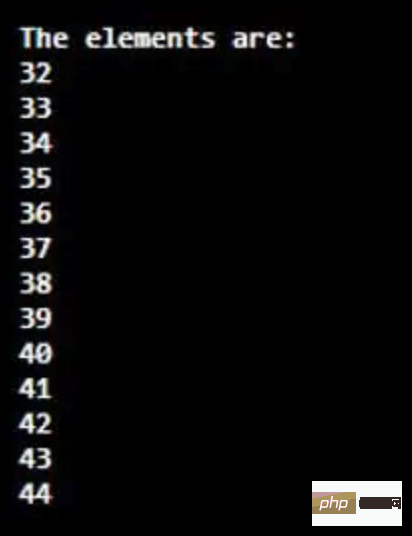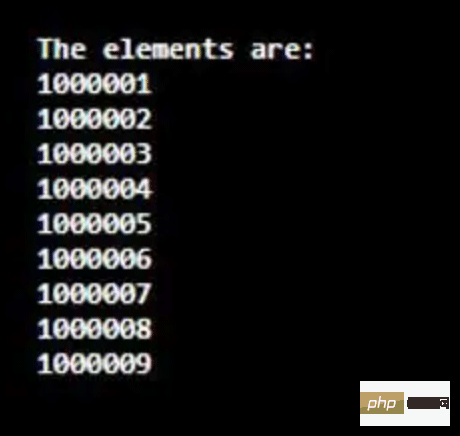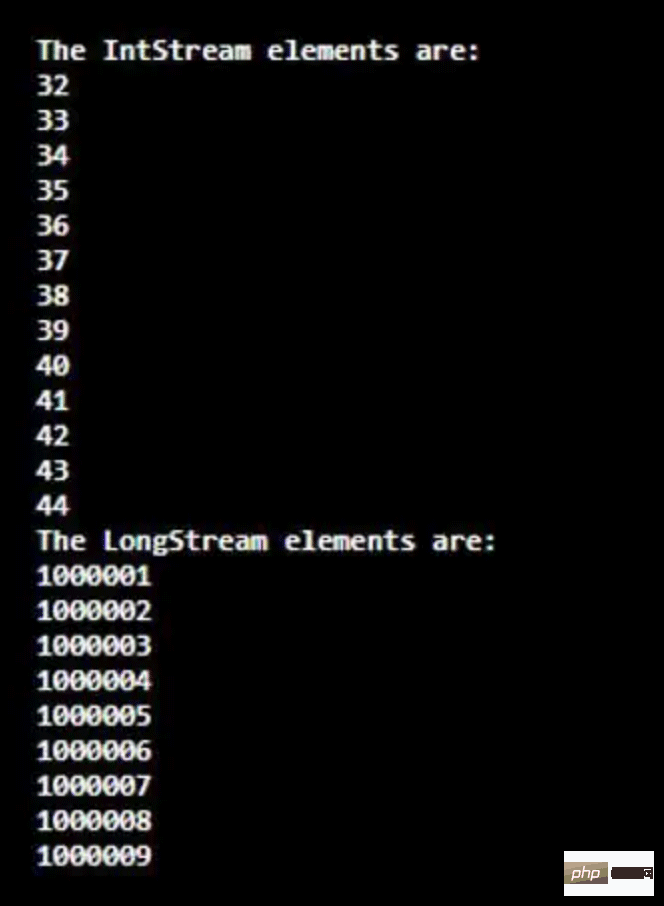How to use Range function in Java
Preface
In Java, the Range method is available in both the IntStream and LongStream classes. In IntStream class, it helps to return the sequential value of IntStream within function parameter scope. In this method, startInclusive(inclusive) and endExclusive(exclusive) are the two parameters used along with the increment step size, which as mentioned before, will include the starting value, and exclude the end value. In the case of LongStream, the only difference is the addition of the LongStream value.
Range Syntax
Let us see the syntax of range method in Java.
Syntax for IntStream range
static IntStream range(int startInclusive, int endExclusive)
Parameters:
IntStream: This is a sequence of int-valued elements of a primitive type.
startInclusive: The initial value included in the range.
endExclusive: The last value or upper limit to exclude in the range.
Return value:
This method returns a continuous int stream of int elements mentioned in the range as parameter.
Syntax for LongStream scope
static LongStream range(int startInclusive, int endExclusive)
Parameters:
LongStream: This is a primitive A sequence of long-valued elements of type.
startInclusive: The initial value included in the range.
endExclusive: The last value or upper limit to exclude in the range.
Return value:
This method returns a continuous long stream of long elements mentioned in the range as argument.
How does the Range function work in Java?
First, let’s see how IntStream scope works in Java. Similar to other classes in Java, this class also requires a package which must be imported first. That is, to use the IntStream class, import package java.util.stream.IntStream. After importing, create an IntStream so that you can add elements to it. After creating the stream, use the method range() to add elements. When the code is executed, a sequence of ordered IntStreams will be returned by one incremental step in the range mentioned in the parameter.
To print each element, use the method shown below.
intStream.forEach(System.out::println);
For LongStream, first import the package java.util.stream.LongStream. Similar to the functionality of IntStream, once the package is imported, a LongStream is created so that elements can be added to it. After creating the stream, add elements using the method range(). When the code is executed, a long stream of sequence order will be returned by one incremental step in the range mentioned in the parameter.
is used to print each element using the method shown below.
LongStream.forEach(System.out::println);
With the help of a for loop, the equivalent print sequence of increasing elements can be generated sequentially,
as follows:
for (inti = startInclusive; i<endExclusive ; i++)
{... . . . }Java Range Example in
The following are the examples mentioned:
Example#1
Java Program to Implement IntStream Range Function .
Code:
// IntStream range implementation using Java
import java.util.*;
//import the package for IntStream
import java.util.stream.IntStream;
public class RangeExample {
// main method
public static void main(String[] args)
{
// Create an IntStream
IntStream st = IntStream.range(32, 45);
// Display the elements in the range mentioned as 32 and 45 where 32 is included and 45 is excluded
System.out.println("The elements are:");
st.forEach(System.out::println);
} }Output:

java.util.stream.IntStream. Then, create an IntStream st to add elements to. During the creation of the stream, the method range(32, 45) is used to add elements, including 32 elements and excluding 45 elements. When the code is executed, an ordered IntStream will be returned in an incremental step from 32 to 44, as shown in the example output.
Example #2
Java program implements the LongStream range function.Code:
// LongStream range implementation using Java
import java.util.*;
//import the package for LongStream
import java.util.stream.LongStream;
public class RangeExample {
// main method
public static void main(String[] args)
{
// Create a LongStream
LongStream st = LongStream.range(1000001L, 1000010L);
// Display the elements in the range mentioned as 1000001L and 1000010L where 1000001L is included and 1000010L is excluded
System.out.println("The elements are:");
st.forEach(System.out::println);
} }Output:

java.util.stream.LongStream. Then, create a LongStreamst with method range(100001L, 100010L) for adding elements to it. As the code is executed, there will be an incremental step back from 100001L to 100010L, as shown in the example output.
Example #3
Java program for combined implementation of LongStream and IntStream range functions.Code:
import java.util.*;
//import the package for IntStream
import java.util.stream.IntStream;
//import the package for LongStream
import java.util.stream.LongStream;
public class RangeExample {
// main method
public static void main(String[] args)
{
// Create an IntStream
IntStream str = IntStream.range(32, 45);
// Display the elements in the range mentioned as 32 and 45 where 32 is included and 45 is excluded
System.out.println("The IntStream elements are:");
str.forEach(System.out::println);
// Create a LongStream
LongStream st = LongStream.range(1000001L, 1000010L);
// Display the elements in the range mentioned as 1000001L and 1000010L where 1000001L is included and 1000010L is excluded
System.out.println("The LongStream elements are:");
st.forEach(System.out::println);
} }Output:

java .util.stream.IntStream and java.util.stream.LongStream. Then, create an IntStreamstr and LongStreamst to add elements to. During creation of the stream, use the method range(32, 45) to add elements in the IntStream including 32 and excluding 45. Similarly, use the method range(100001L, 100010L) to add elements in the LongStream. When the code is executed, the sequenced IntStream will return from 32 to 44 and the LongStream will return from 100001L to 100010L with an incremental step of 1.
The above is the detailed content of How to use Range function in Java. For more information, please follow other related articles on the PHP Chinese website!

Hot AI Tools

Undresser.AI Undress
AI-powered app for creating realistic nude photos

AI Clothes Remover
Online AI tool for removing clothes from photos.

Undress AI Tool
Undress images for free

Clothoff.io
AI clothes remover

Video Face Swap
Swap faces in any video effortlessly with our completely free AI face swap tool!

Hot Article

Hot Tools

Notepad++7.3.1
Easy-to-use and free code editor

SublimeText3 Chinese version
Chinese version, very easy to use

Zend Studio 13.0.1
Powerful PHP integrated development environment

Dreamweaver CS6
Visual web development tools

SublimeText3 Mac version
God-level code editing software (SublimeText3)

Hot Topics
 Break or return from Java 8 stream forEach?
Feb 07, 2025 pm 12:09 PM
Break or return from Java 8 stream forEach?
Feb 07, 2025 pm 12:09 PM
Java 8 introduces the Stream API, providing a powerful and expressive way to process data collections. However, a common question when using Stream is: How to break or return from a forEach operation? Traditional loops allow for early interruption or return, but Stream's forEach method does not directly support this method. This article will explain the reasons and explore alternative methods for implementing premature termination in Stream processing systems. Further reading: Java Stream API improvements Understand Stream forEach The forEach method is a terminal operation that performs one operation on each element in the Stream. Its design intention is
 PHP: A Key Language for Web Development
Apr 13, 2025 am 12:08 AM
PHP: A Key Language for Web Development
Apr 13, 2025 am 12:08 AM
PHP is a scripting language widely used on the server side, especially suitable for web development. 1.PHP can embed HTML, process HTTP requests and responses, and supports a variety of databases. 2.PHP is used to generate dynamic web content, process form data, access databases, etc., with strong community support and open source resources. 3. PHP is an interpreted language, and the execution process includes lexical analysis, grammatical analysis, compilation and execution. 4.PHP can be combined with MySQL for advanced applications such as user registration systems. 5. When debugging PHP, you can use functions such as error_reporting() and var_dump(). 6. Optimize PHP code to use caching mechanisms, optimize database queries and use built-in functions. 7
 PHP vs. Python: Understanding the Differences
Apr 11, 2025 am 12:15 AM
PHP vs. Python: Understanding the Differences
Apr 11, 2025 am 12:15 AM
PHP and Python each have their own advantages, and the choice should be based on project requirements. 1.PHP is suitable for web development, with simple syntax and high execution efficiency. 2. Python is suitable for data science and machine learning, with concise syntax and rich libraries.
 PHP vs. Other Languages: A Comparison
Apr 13, 2025 am 12:19 AM
PHP vs. Other Languages: A Comparison
Apr 13, 2025 am 12:19 AM
PHP is suitable for web development, especially in rapid development and processing dynamic content, but is not good at data science and enterprise-level applications. Compared with Python, PHP has more advantages in web development, but is not as good as Python in the field of data science; compared with Java, PHP performs worse in enterprise-level applications, but is more flexible in web development; compared with JavaScript, PHP is more concise in back-end development, but is not as good as JavaScript in front-end development.
 PHP vs. Python: Core Features and Functionality
Apr 13, 2025 am 12:16 AM
PHP vs. Python: Core Features and Functionality
Apr 13, 2025 am 12:16 AM
PHP and Python each have their own advantages and are suitable for different scenarios. 1.PHP is suitable for web development and provides built-in web servers and rich function libraries. 2. Python is suitable for data science and machine learning, with concise syntax and a powerful standard library. When choosing, it should be decided based on project requirements.
 Java Program to Find the Volume of Capsule
Feb 07, 2025 am 11:37 AM
Java Program to Find the Volume of Capsule
Feb 07, 2025 am 11:37 AM
Capsules are three-dimensional geometric figures, composed of a cylinder and a hemisphere at both ends. The volume of the capsule can be calculated by adding the volume of the cylinder and the volume of the hemisphere at both ends. This tutorial will discuss how to calculate the volume of a given capsule in Java using different methods. Capsule volume formula The formula for capsule volume is as follows: Capsule volume = Cylindrical volume Volume Two hemisphere volume in, r: The radius of the hemisphere. h: The height of the cylinder (excluding the hemisphere). Example 1 enter Radius = 5 units Height = 10 units Output Volume = 1570.8 cubic units explain Calculate volume using formula: Volume = π × r2 × h (4
 PHP: The Foundation of Many Websites
Apr 13, 2025 am 12:07 AM
PHP: The Foundation of Many Websites
Apr 13, 2025 am 12:07 AM
The reasons why PHP is the preferred technology stack for many websites include its ease of use, strong community support, and widespread use. 1) Easy to learn and use, suitable for beginners. 2) Have a huge developer community and rich resources. 3) Widely used in WordPress, Drupal and other platforms. 4) Integrate tightly with web servers to simplify development deployment.
 Create the Future: Java Programming for Absolute Beginners
Oct 13, 2024 pm 01:32 PM
Create the Future: Java Programming for Absolute Beginners
Oct 13, 2024 pm 01:32 PM
Java is a popular programming language that can be learned by both beginners and experienced developers. This tutorial starts with basic concepts and progresses through advanced topics. After installing the Java Development Kit, you can practice programming by creating a simple "Hello, World!" program. After you understand the code, use the command prompt to compile and run the program, and "Hello, World!" will be output on the console. Learning Java starts your programming journey, and as your mastery deepens, you can create more complex applications.






